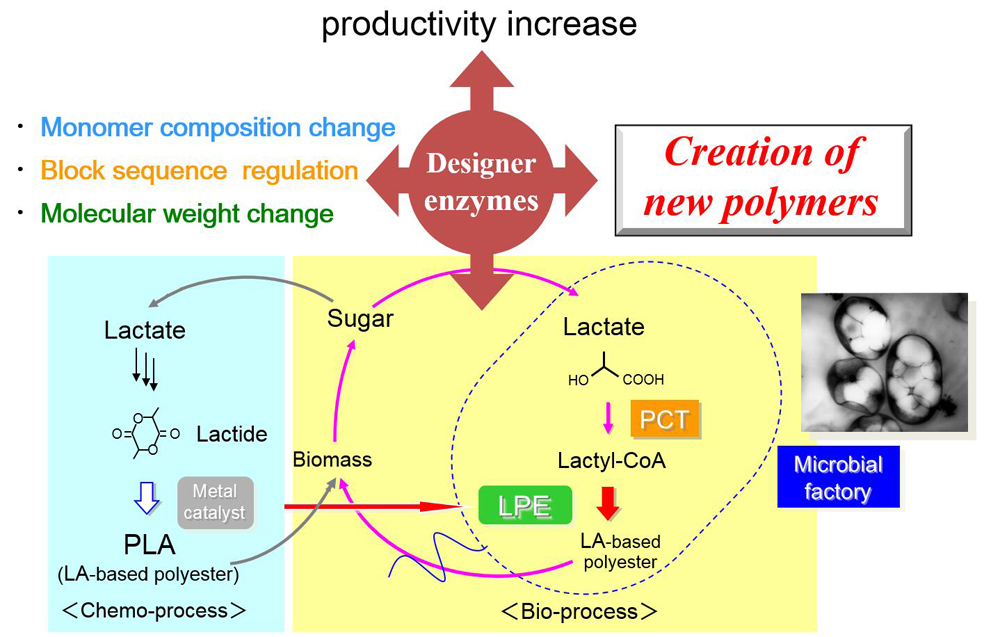

Frontiers of Chemical Science and Engineering >
Designer enzyme for green materials innovation: Lactate-polymerizing enzyme as a key catalyst
Received date: 30 Aug 2016
Accepted date: 16 Jan 2017
Published date: 17 Mar 2017
Copyright
Establishment of the regeneratable whole-cell catalyst platform for the production of biobased polymeric materials is a typical topic of synthetic biology. In this commentary, discovery story of a “lactate-polymerizing enzyme” (LPE) and LPE-based achievements for creating a new variety of polyesters with incorporated unnatural monomers are presented. Besides the importance of microbial platform itself is discussed referring to the “ballooning”-Escherichia coli.

Seiichi Taguchi . Designer enzyme for green materials innovation: Lactate-polymerizing enzyme as a key catalyst[J]. Frontiers of Chemical Science and Engineering, 2017 , 11(1) : 139 -142 . DOI: 10.1007/s11705-017-1636-0
| 1 |
Lemoignei M. Produits dedehydration et de polymerisation delacideßoxobutyrique. Bulletin de la Société de Chimie Biologique, 1926, 8: 770–782
|
| 2 |
Doi Y, Steinbühel A.Methabolic Pathways and Engineering of PHA Biosynthesis. Weinheim: Wiley-VCH Verlag GmbH, 2002, 217–247
|
| 3 |
Lenz R W, Marchessault R H. Bacterial polyesters: Biosynthesis, biodegradable plastics and biotechnology. Biomacromolecules, 2005, 6(1): 1–8
|
| 4 |
Anderson A J, Dawes E A. Occurrence, metabolism, metabolic role, and industrial uses of bacterial polyhydroxyalkanoates. Microbiological Reviews, 1990, 54(4): 450–472
|
| 5 |
Ryner M, Stridsberg K, Albertsson A N, von Schenck H, Svensson M. Mechanism of ring-opening polymerization of 1,5-dioxepan-2-one and
|
| 6 |
Rehm B H. Polyester synthases: Natural catalysts for plastics. Biochemical Journal, 2003, 376(1): 15–33
|
| 7 |
Taguchi S, Doi Y. Evolution of polyhydroxyalkanoate (PHA) production system by “enzyme evolution”: Successful case studies of directed evolution. Macromolecular Bioscience, 2004, 4(3): 146–156
|
| 8 |
Nomura C T, Taguchi S. PHA synthase engineering toward superbiocatalysts for custom-made biopolymers. Applied Microbiology and Biotechnology, 2006, 73(5): 969–979
|
| 9 |
Taguchi S, Yamada M, Matsumoto K, Tajima K, Satoh Y, Munekata M, Ohno K, Kohda K, Shimamura T, Kambe H,
|
| 10 |
Tajima K, Satoh Y, Satoh T, Itoh R, Han X, Taguchi S, Kakuchi T, Munekata M. Chemo-enzymatic synthesis of poly(lactate-co-(3-hydroxybutyrate)) by a lactate-polymerizing enzyme. Macromolecules, 2009, 42(6): 1985–1989
|
| 11 |
Taguchi S. Current advances in microbial cell factories for lactate-based polyesters driven by lactate-polymerizing enzymes: Toward further creation of new LA-based polyesters. Polymer Degradation & Stability, 2010, 95(8): 1421–1428
|
| 12 |
Park S J, Kim T W, Kim M K, Lee S Y, Lim S C. Advanced bacterial polyhydroxyalkanoates: Towards a versatile and sustainable platform for unnatural tailor-made polyesters. Biotechnology Advances, 2012, 30(6): 1196–1206
|
| 13 |
Matsumoto K, Taguchi S. Enzyme and metabolic engineering for the production of novel polymers: Crossover of biological and chemical processes. Current Opinion in Biotechnology, 2013, 24(6): 1054–1060
|
| 14 |
Matsumoto K, Taguchi S. Biosynthetic polyesters consisting of 2-hydroxyalkanoic acids: Current challenges and unresolved questions. Applied Microbiology and Biotechnology, 2013, 97(18): 8011–8021
|
| 15 |
Volodina E, Schürmann M, Lindenkamp N, Steinbüchel A. Characterization of propionate CoA-transferase from Ralstoniaeutropha H16. Applied Microbiology and Biotechnology, 2014, 98(8): 3579–3589
|
| 16 |
Wittenborn E C, Jost M, Wei Y, Stubbe J A, Drennan C L. Structure of the catalytic domain of the class I polyhydroxybutyrate synthase from Cupriavidusnecator. Journal of Biological Chemistry, 2016, 291(48): 25264–25277
|
| 17 |
Yamada M, Matsumoto K, Uramoto S, Motohashi R, Abe H, Taguchi S. Lactate fraction dependent mechanical properties of semitransparent poly(lactate-co-3-hydroxybutyrate)s produced by control of lactyl-CoA monomer fluxes in recombinant Escherichia coli. Journal of Biotechnology, 2011, 154(4): 255–260
|
| 18 |
Utsunomia C, Matsumoto M, Taguchi S. Micobial secretion of
|
| 19 |
Kadoya R, Matsumoto K, Ooi T, Taguchi S. MtgA deletion-triggered cell enlargement of Escherichia coli for enhanced intracellular polyester accumulation. PLoS One, 2015, 10(6): e0125163
|
| 20 |
Wu H, Chen J, Chen G Q. Engineering the growth pattern and cell morphology for enhanced PHB production by Escherichia coli. Applied Microbiology and Biotechnology, 2016, 100(23): 9907–9916
|
/
| 〈 |
|
〉 |